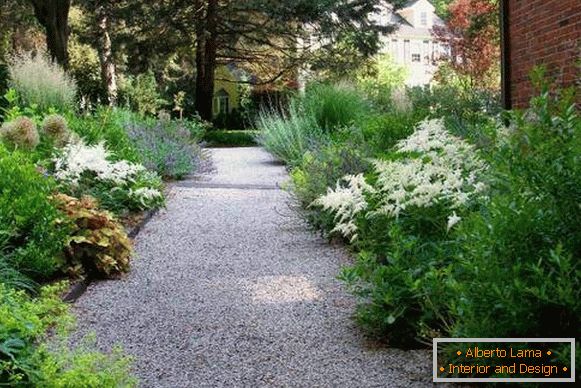
In the conditions of the severe Russian climate, I want to keep the summer as long as possible and not let the winter free, protecting it from my house. Since the middle of autumn nature begins to wither, with the onset of the first frosts it freezes in a deep sleep until the spring awakening. Depressing picture: snowdrifts, "bald spots" of dirt, black trees with bare branches. Such a landscape really tends to depress and causes a breakdown. But who said that it is necessary to let winter into your house? It is easy to stop, keeping a piece of greenery, flowering and life. Summer is simply "canned" in a separate room, where many plants are grown. This is not an ordinary corner of living flora, and not a group of flowers in pots, but a real winter garden, with its own atmosphere and a special microclimate. Its appearance and development is closely connected with the emergence of primitive heating, irrigation systems and methods of isolating individual rooms, in order to preserve heat. In closed constructions round the clock a strictly defined temperature is maintained, in expensive variants a special technique is used that simulates various natural phenomena (rain, wind). The design of the winter greenhouse, in fact, is a mixture of the design of interiors and landscapes in the suburban area. On how to equip a beautiful, impressive winter garden, in which there is a place for both exotic and ordinary "summer" plants, and we'll talk further.
At the same time, active trade in exotic plants begins and opens a new way of transportation - in Ward's boxes, which have become the prototype of modern florariums. Orange trees popular in Europe are designed "orange houses" - a kind of greenhouses. For other citrus, date trees and heat-loving palms, special greenhouses are created. But the nobles and their entourage liked not only to visit their "green corners" occasionally, but also to spend holidays there, so the hothouse method of planting plants in a partially insulated ground was replaced with "room", that is, in pots and kadushki. This allowed to free up more space, and the winter gardens themselves were moved to spacious pavilions of palaces. That's how they appeared in the form that is familiar to each of us. To create a full-fledged winter garden attracted designers, architects and professional gardeners. Until now, one of the most beautiful world greenhouses is the Versailles, which was built in the time of Louis XIV. The king had a weakness for citrus, so most of the garden is occupied by oranges. The greenhouse is still functioning, although it survived the restoration and redevelopment, which changed its authentic look. For a long time the winter garden was considered the lot of private possessions and it was not until the end of the XIX century that they were placed in luxury apartments. The first in Russia idea of planting plants in enclosed premises was used by churchmen. Monks thus cultivated vegetables and fruits year-round.
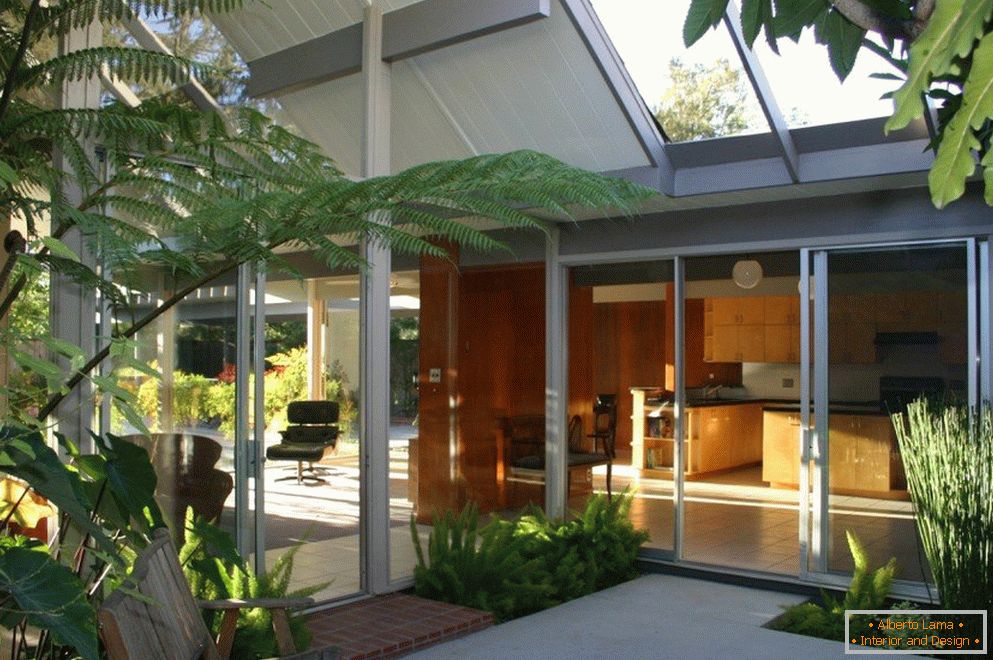

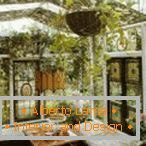
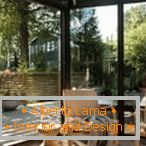


In the conditions of the Russian climate, there is simply no other reliable option, except for a winter garden, to conserve exotic, heat-loving plants. Orange, pomegranate trees, lemons and mangoes are sometimes planted in the open ground, but surrounded by a sturdy construction with thermal insulation for wintering, which is associated with annual hassle in the run-up to winter.
Features and layout options
To create a winter garden at home, you need to consider several rules, non-compliance which will make the entire campaign a failure:
- The greenhouse should have good illumination, sufficient for the growth of different plants. For this reason, its walls and roof are often made of glass or other transparent material;
- think through the right arrangement of communication lines for heating and ventilation systems. The first is required in winter, and the second in summer. The need for them is eliminated if the winter garden is located in a buffer room;
- if the budget allows, the greenhouse is also provided with an automatic irrigation system. This will remove most of the worries about the garden from the owners. In the economical options, you will have to independently irrigate with a watering can and spray.

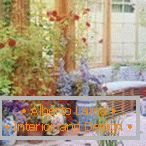

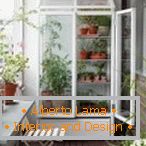
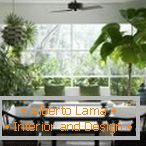
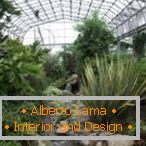
In addition, it will be necessary to carry out all the usual procedures for gardeners and gardeners: loosen and replace once a couple of years, ground, cut, remove diseased or weak branches, fertilize and treat plants from diseases, pests, plant too overgrown bushes or transfer them to more spacious ones Kadushki, where the entire root system will fit. Depending on the functional purpose, winter gardens are classified into three types:
- residential - they are comfortable not only for plants, but for humans;
- greenhouses - this room is intended exclusively for flora;
- buffer garden - it is equipped in a "cold" building, which can only be used in certain seasons (in summer).
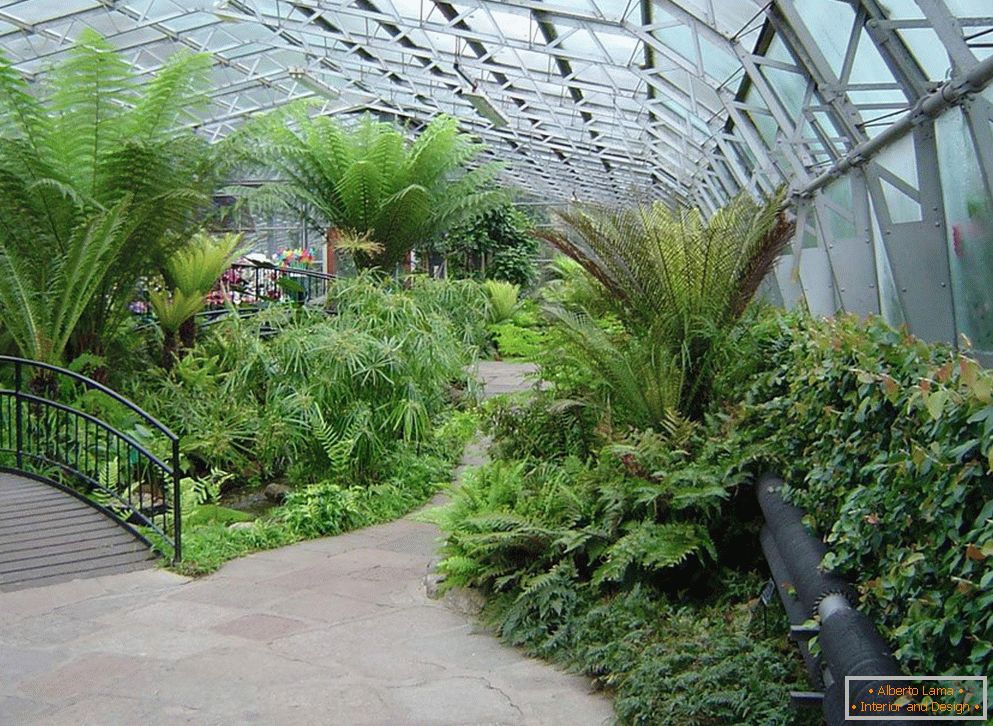
Depending on the location of the winter garden in relation to the main building (country house, cottage, dacha), they are divided into three groups:
- Built-in. They are located inside the dwelling and are often used in urban apartments where there is no way to equip the winter garden separately. As a "victim" they usually use a balcony or a loggia. Separate rooms are converted to a winter garden only in rare cases, if the apartment is too spacious with an excess of useful space or the cottage has a second (third) floor. Great looks solution with the placement of a greenhouse under a glass roof dome.
- Attached. They represent an additional pavilion, which is usually erected much after the construction of the house. To get into such a garden, you do not have to leave the house. The buffer extensions, as a rule, separate the dwelling from the street, that is, in fact, these are converted verandas.
- Stand-alone. If the size of a private plot allows, it is possible to equip a huge greenhouse that completely replaces an open garden. Such a solution will be effective in a highly capricious climate, which "kills" most of the seedlings. Also beautiful look gilded pavilions, which are warmed and forced by kadushkas and pots with plants.
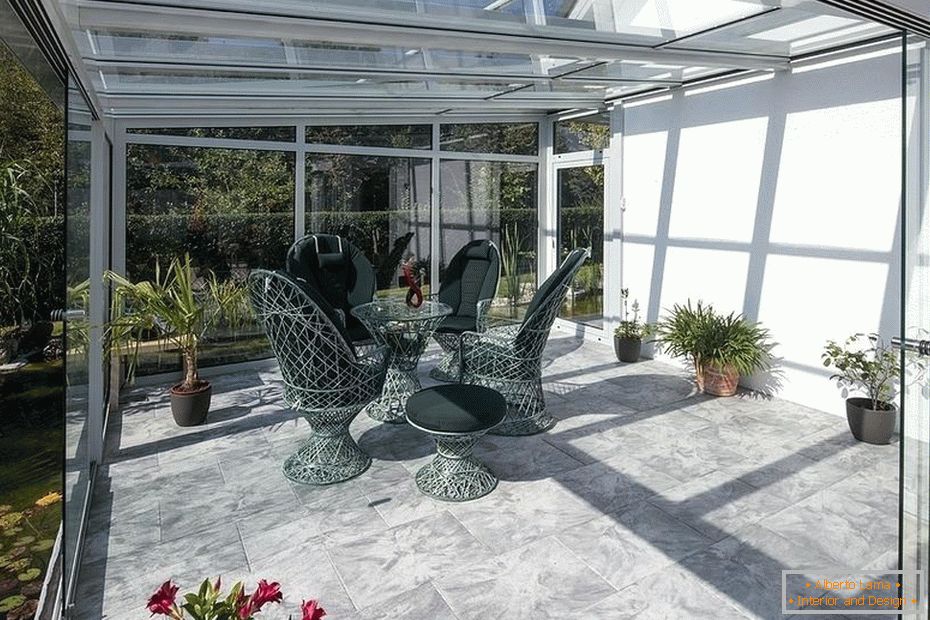



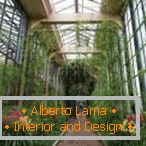
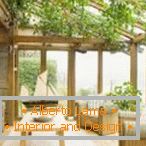
Depending on the location relative to the sides of the world, the winter gardens are classified into four types:
- Northern. Most of their windows "look" to the north. Although the room will quickly accumulate heat, it will not be able to hold it for long. In such gardens it is recommended to install a heating system of high quality.
- Eastern. The most optimal option of all. Plants will get enough light, but they will not overheat.
- Western. They are characterized by the preservation of heat over a long period. However, in the hot, arid summer, this dignity is re-qualified as a defect, as the winter garden turns into a steam room.
- Southern. In such gardens, by analogy with the western ones, overheating occurs in a hot period. It will be necessary to equip ventilation for the circulation of air flows and an irrigation system for irrigation.
Types of structures
The structures of winter gardens differ in the form of the buildings themselves, the types of roofs (one-pitch, two-slope, four-five-beam, with a break, domes) and materials of execution. If the first two characteristics completely depend on the style of the landscape design of the site and the appearance of the exterior of the house, which is adjacent to it, then in the latter case, the strength plays a role and functionality. For the construction of winter gardens use:
- Aluminum. Durable, reliable and lightweight material that is not corroded. It is usually created by mobile structures that are easily assembled and dismantled. Aluminum beams are not deformed, but because of the special strength of the material, the profile is made thin.
- Wooden. Classical material, which was used even in times of the first greenhouse constructions. Wood is a whim and impractical, because it will have to be systematically treated with special compounds that protect against moisture, pest infestations, fungi and mold. Otherwise, the wooden structure will begin to rot, deform and eventually become unusable. To build a winter garden, use birch, oak, pine, larch. The undeniable advantage of the tree array is its naturalness and special beauty.
- Polyvinyl chloride. PVC is relatively cheap, and making custom-made designs will make it possible to embody the boldest ideas of decoration. However, plastic greenhouses can not withstand heavy loads, so the overall space will have to be further strengthened.
- Metal-plastic. This material has gathered the advantages of two main "components". From plastic, he took lightness, anti-corrosion and the ability to take any shape in the manufacture, and in metal alloys, he took strength and relative flexibility.
- All-glass. For such structures use a special kind of tempered, laminated glass. It perfectly passes light, but it does not react even to strong strokes, since the triplex possesses super strength. If the surface still succeeds in inflicting a crushing blow, it will only be covered with a pattern of cracks, keeping the fragments in place.
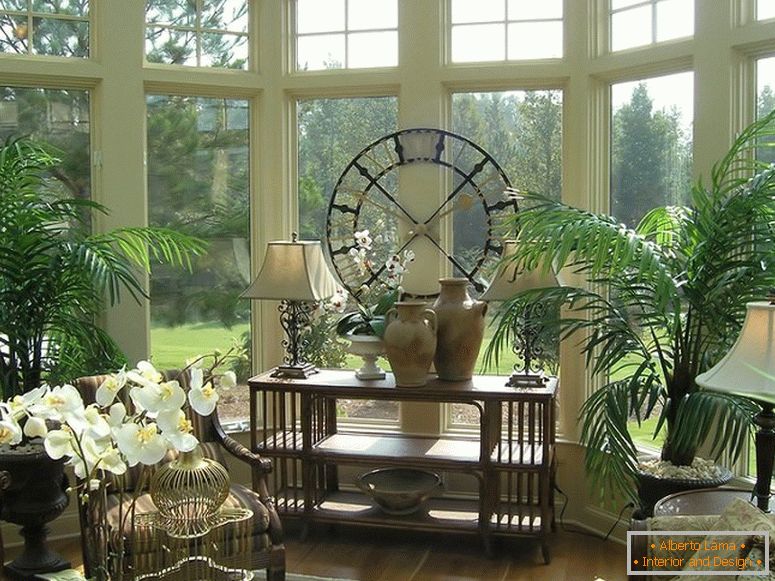

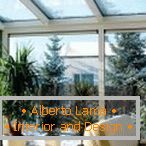

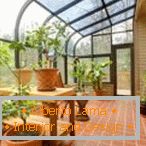

Also, designs differ in the types of doors and windows that they are equipped with.
Lighting
Correct lighting is the key to the well-being of the "inhabitants" of the winter garden. It would seem that it can be simpler than to install a pair of lamps and spot decorative lamps to fill the plants with light. But in fact, everything is not so easy. Some plants like a shadow (for example, tropical), and others need a lot of light for comfort. The power of the lamps and the intensity of illumination should be selected in accordance with the rules for the cultivation of certain species. This is especially important in the conditions of our climate, since in the winter the sun is rarely seen, which means that the lack of its attention will have to be compensated artificially. In principle, a winter garden can be equipped with even ordinary incandescent lamps, but they are more suitable for premises where people live, not plants. Their light spectrum is devoid of blue and red rays, which are necessary for a full-fledged growth of the flora. In addition, they have high heat emission, which can burn out plant leaves and provoke their wilting. Experts recommend choosing fluorescent lamps. They give a powerful stream of light, have a low heat dissipation and excellent energy-saving characteristics.
Read also: Indoor plants in the interior: design and care for flowers 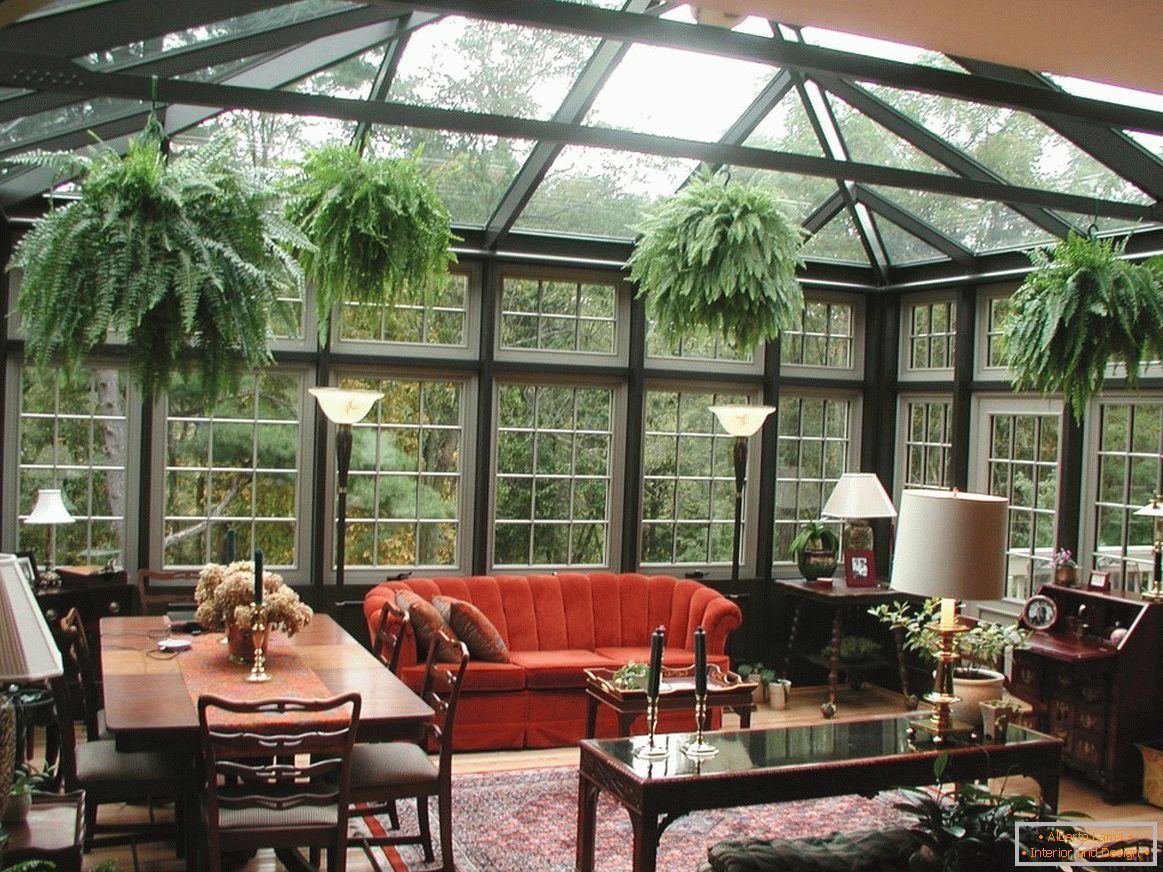


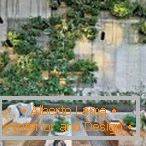
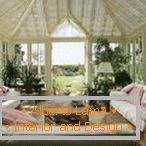

Ventilation and heating system
In addition to central or autonomous heating devices located around the perimeter of the room, it is necessary to install special infrared heaters. They are panels that are fixed to walls or ceiling. This spare option is useful during especially harsh winters, when the main system can not cope with the task. Such reinsurance is necessary in winter gardens, the construction of which consists of glass more than 50%. Another option for additional heating - a modern "warm" floor, the temperature of which can be adjusted. With him will be comfortable not only plants, but also people strolling through the greenhouse in slippers. The ventilation system can be artificial or natural. Either way, fresh air to plants is vital. If the garden is cultivated unpretentious species that calmly tolerate average temperatures, then natural ventilation is suitable. An artificial or mechanical variant is used for moody plants, which react sharply to any changes in the environment. This ventilation allows you to monitor and adjust the circulation of air flows.
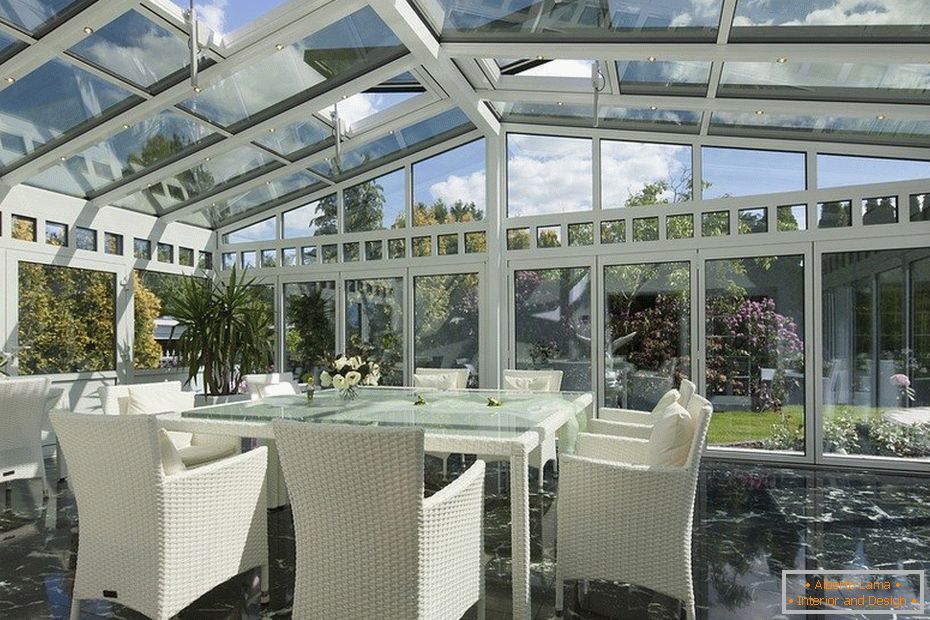


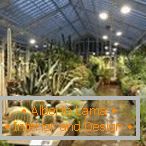
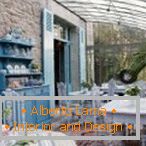
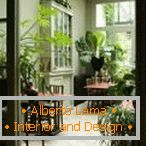
Styles and tips for design
The winter garden, like the house, has its own stylistic solutions. Ethnic directions are used for its registration, since the practice of decorating these premises in each country has followed its own path of development. Popular is a group of European styles, which include Dutch, French, English and Mediterranean. In these countries, the winter garden has become an integral part of suburban possessions. For lovers of exotic flora fit African, Moorish or Mexican pavilion.
Classic style
In the classical winter garden there is a place for every member of the family. The floor is finished with stone, and the walls are plastered. The window frames are painted white. Decorate the room with panels of wood. To preserve the spirit of conservatism, from furniture choose a soft sofa with a coffee-colored upholstery, a pair of chairs to it in tone, a large round table for lunch, covered with a tablecloth. It will be appropriate to place an antique cupboard for dishes. From plants choose palm trees, ferns, clematis and lianas. A stylish element in the decoration of the winter garden will be a fireplace.


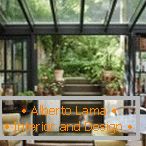



English style
Англичане полюбили зимние сады настолько, что большую часть своего свободного времени до сих пор проводят здесь. В оранжерее отдыхают, пьют чай, принимают гостей и даже устраивают скромные семейные праздники. English style делится на несколько направлений, которые соответствуют определенной эпохе в жизни страны:
- Victorian. Style appeared during the reign of Queen Victoria. In the interior they do not save in ornaments, and the construction itself has a rectangular shape with a rounded end and a gable roof.
- Georgian. The design is in the form of a semicircle with a flat roof. The windows are decorated with frequent internal partitions.
- Edwardian. The winter garden has a strict rectangular shape, and its hobby is adorned with an exterior decoration. In the interior design adhere to the principles of restraint.

In the English winter gardens, the windows are decorated with stained glass, and the floors are covered with large, soft carpets. Furniture choose antique, preferably antiques. You can also use wicker chairs and sofas. A coffee table is covered with a tablecloth with floral ornament.
French style
In the French style, they observe strictness and orderliness. Shrubs in the winter garden are always neatly trimmed. The furniture uses a soft and voluminous, as in a full living room. In the color palette prevail pink, blue, white and gold. The interior of the winter garden is ideal for personal meetings and relaxing holidays alone. Its ambience is luxurious. In a living "filling" flowers and exotic fruits, medicinal plants, vegetables and spicy herbs prevail. Kadushki and pots with them put on special elevations, so that the greenery could be clearly seen from anywhere in the winter garden. Furniture choose a massive with expensive upholstery. In the decor, mirrors are used in gilded vases, stucco, skillfully executed porcelain vases, sculpture and floor lamps with a floral pattern.
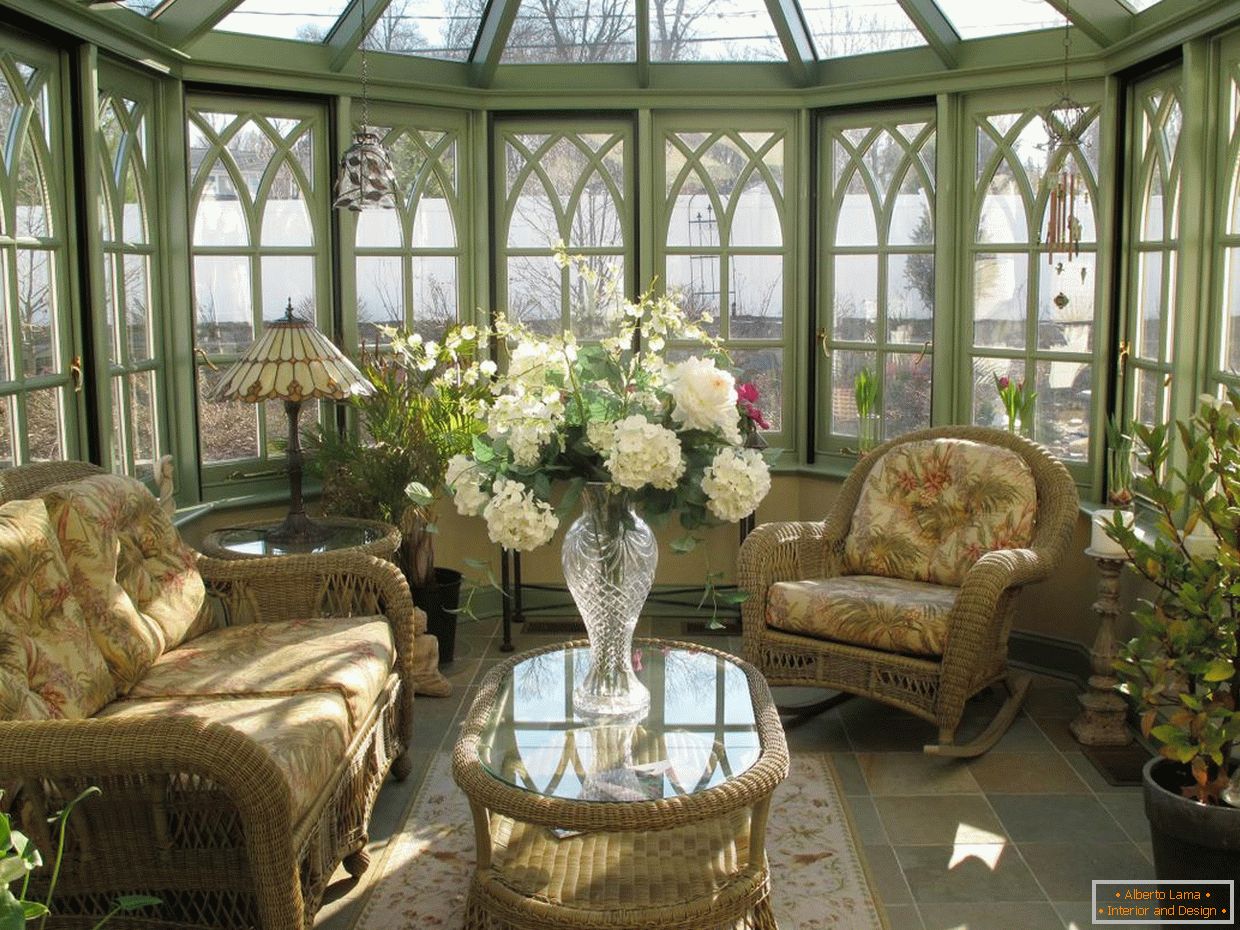



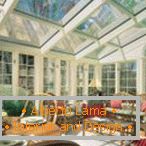
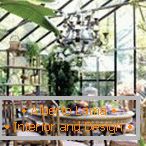
Mediterranean
Mediterranean стиль отличается лаконизмом. Пол зимнего сада отделывают керамической плиткой, а стены окрашивают в такие цвета, чтобы создавалось впечатление «выгоревшей» под палящим солнцем поверхности. Конструкция, как правило, имеет прямоугольную форму и примыкает к дому. В этой части Европы устоялся теплый климат, который летом не щадит никого, поэтому помещение используется в качестве спасительного оазиса от зноя. В насаждениях превалируют фруктовые деревья и пряные травы. Декорируют помещение скульптурами, фонтанчиками и романтичными перголами, увитыми плетущимися розами. Мебель используют простую и лаконичную с элементами ковки.
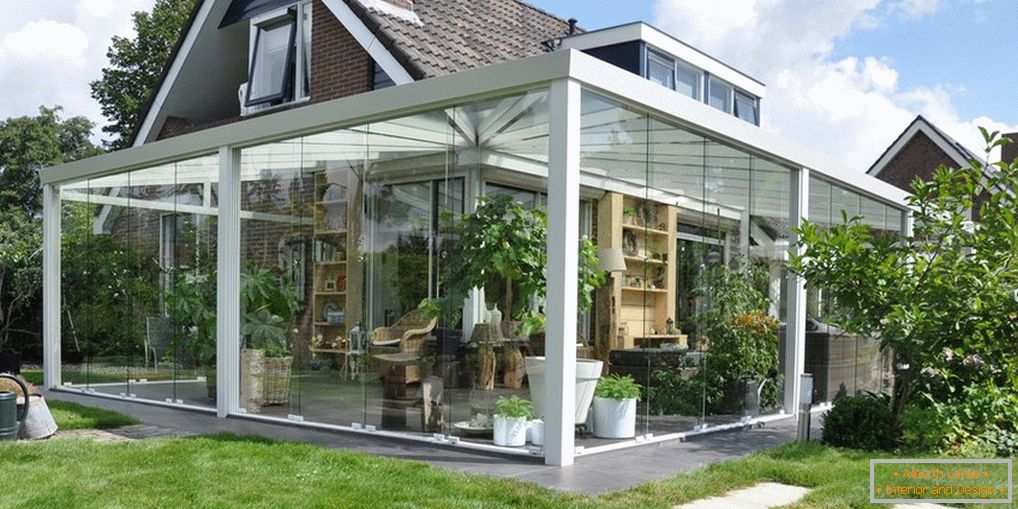
Japanese style
To create a Japanese winter garden, not having deep knowledge in Eastern philosophy, is quite difficult. The decisive role in its design will be played by the correct composition of the composition. The Japanese use the complex scheme to identify the "energy" points, that is, the accent zones, which in traditional versions there are four. The winter garden becomes a place where three elements collide: air, earth and water. Indoors necessarily there are artificial reservoirs, rock gardens, compositions from dwarf trees, moss and stone toro toro. They rest on broad benches. Japanese winter garden - the best place for tea ceremonies and quiet rest alone.
See also: Flowers in the interior of the apartment and the house 

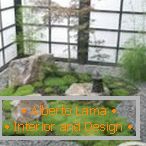


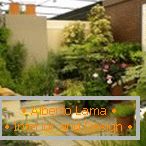
In the style of high-tech
In the style of high-tech можно создать лаконичный сад будущего. В нем превалируют простые формы и строгий порядок. Горшки с растениями расставляют на белоснежных полках. Никакой природной асимметрии в таком зимнем саду быть не должно. В отделке используют обилие стекла, пластика, хромированных элементов декора и соблюдают принцип свободного пространства «для маневра». Пол в помещении либо наливной, либо из паркетной доски черного, коричневого цвета. Стены декорируют пластиковыми панелями или просто покрывают белой штукатуркой. Дополнительно их украшают фотогалереей с авторскими снимками. В цветовой гамме превалируют нейтральный серый, белый и черный. Место для отдыха обставляют угловатой мягкой мебелью и низеньким кофейным столиком из стекла. Из растений выбирают плетущиеся виды и разнообразные пальмы, кактусы.
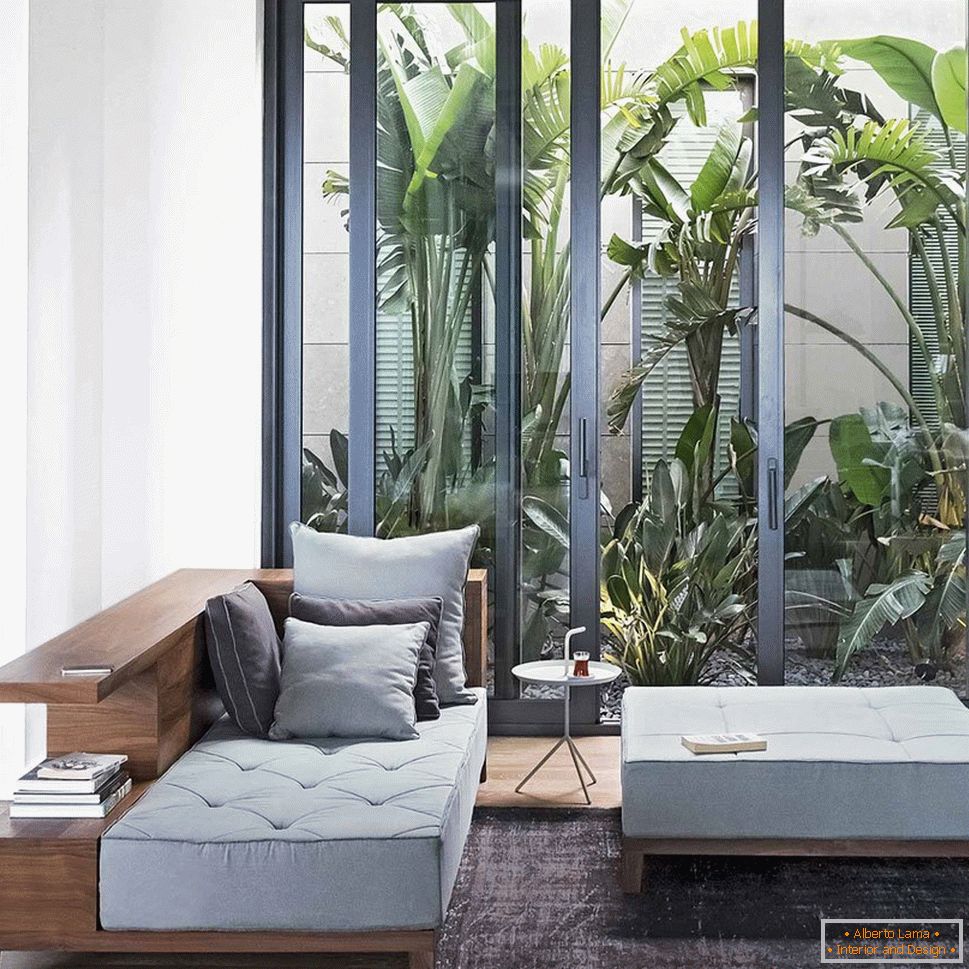
Country Style
The country garden is literally buried in greenery. Pots and kadushki arrange in a chaotic disorder. Since the direction is characterized by a rural flavor, among the flowers and fruit trees, neat vegetable beds with greens, onions, tomatoes and cucumbers are seen, that is, the garden is combined with a greenhouse. The floor and walls are trimmed with roughly processed wood or tiles. The ceiling is plastered. Furniture use wicker, light. The sofa is covered with a rug and decorated with a group of pads. The table is covered with a coquettish checkered cloth.
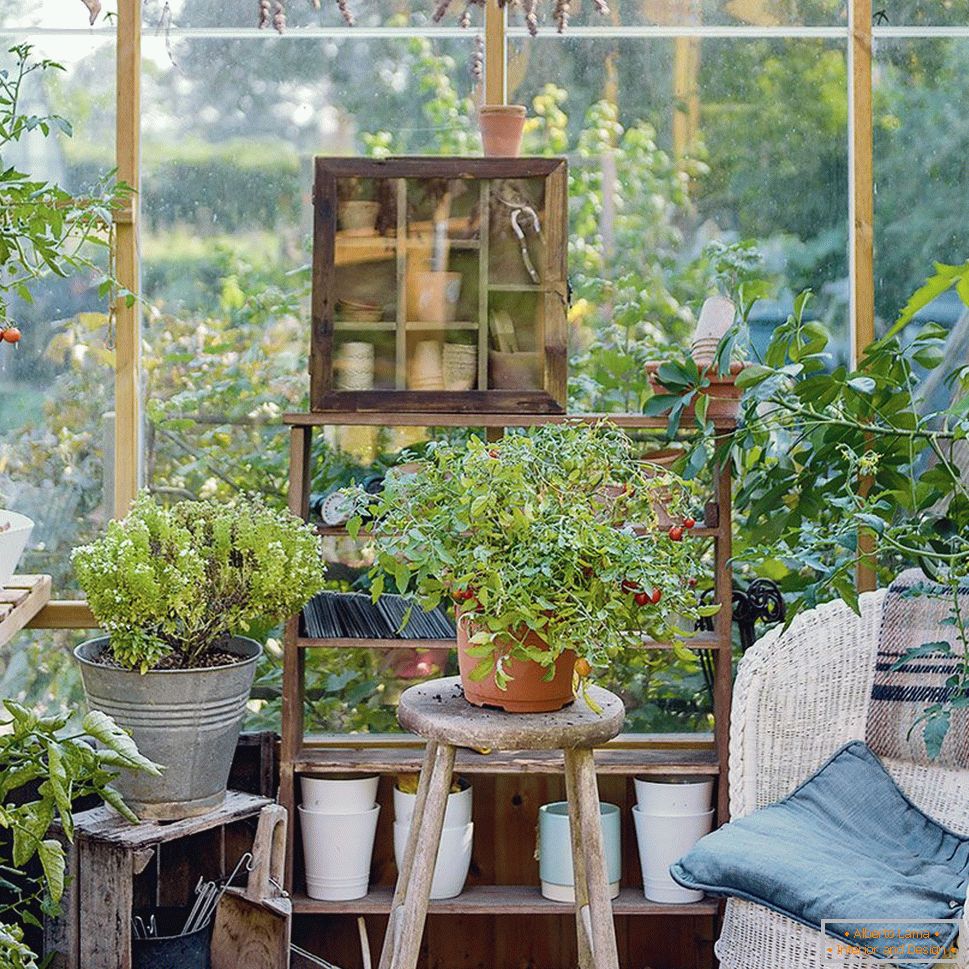
Selection of plants
For a winter garden choose plants of the following types:
- Heat-loving flowers.
- Fruit trees in kadushki.
- The palms.
- Spices.
- Typical houseplants.
- Wattling views.
- Vegetables on miniature beds.
- Water or coastal species, if in the winter garden there is an artificial pond.
- Exotics.
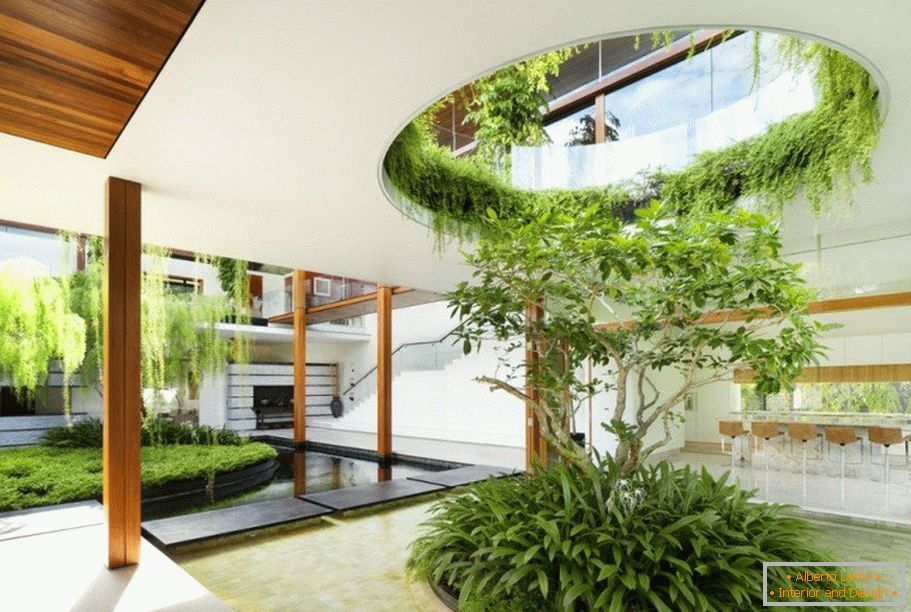

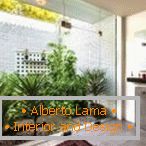



When choosing plants, it is worth paying attention to the temperature regime, which is maintained in the winter. If the values do not exceed 15-17 degrees, then the species typical of the subtropics is cultivated in the garden: azaleas, ficus, palms, shrub, ivy, jasmine, lianas, dracenes, begonias, spathiphyllum and anthurium. In this garden, you can not make drafts and sudden temperature changes. Grow in the tropics in the greenhouse, where it is maintained at 20-15 degrees. Ficuses, kalatei, diffenbachia, arrowroots, anthuriums, guzmanias, frizees and callas will feel good here. Such plants should grow in the penumbra, the abundance of sunlight will be disastrous for them. The humidity level should not fall below 70%. In cool gardens, where the temperature does not exceed 10 degrees in winter, more resistant plants and trees are grown: ferns, eucalyptus, rhododendrons, laurels, fuchsia, aloe, calanchoe, pelargonium and citrus. In winter, the room should be provided with additional lighting, otherwise the living "scenery" will lose its aesthetic appearance: their leaves will become shallow, and the branches will stretch.
Location on the balcony / loggia in the apartment
Balcony or loggia is increasingly considered as an additional functional area. The use of this space for the arrangement of the winter garden has recently become popular. Of course, the balcony will have to be glazed and equipped with a warm floor. Windows must be equipped with blinds, which will help regulate the intensity of sunlight. Pots and kadushki put not only on a floor and a window sill. For them, they are equipped with special shelves with pedestals and acquire pots that are suspended from the ceiling. With a dream of a large conservatory, owners of cramped apartments with balconies will have to say goodbye, but a mini-greenhouse with a place for rest will fit into such a modest framework.
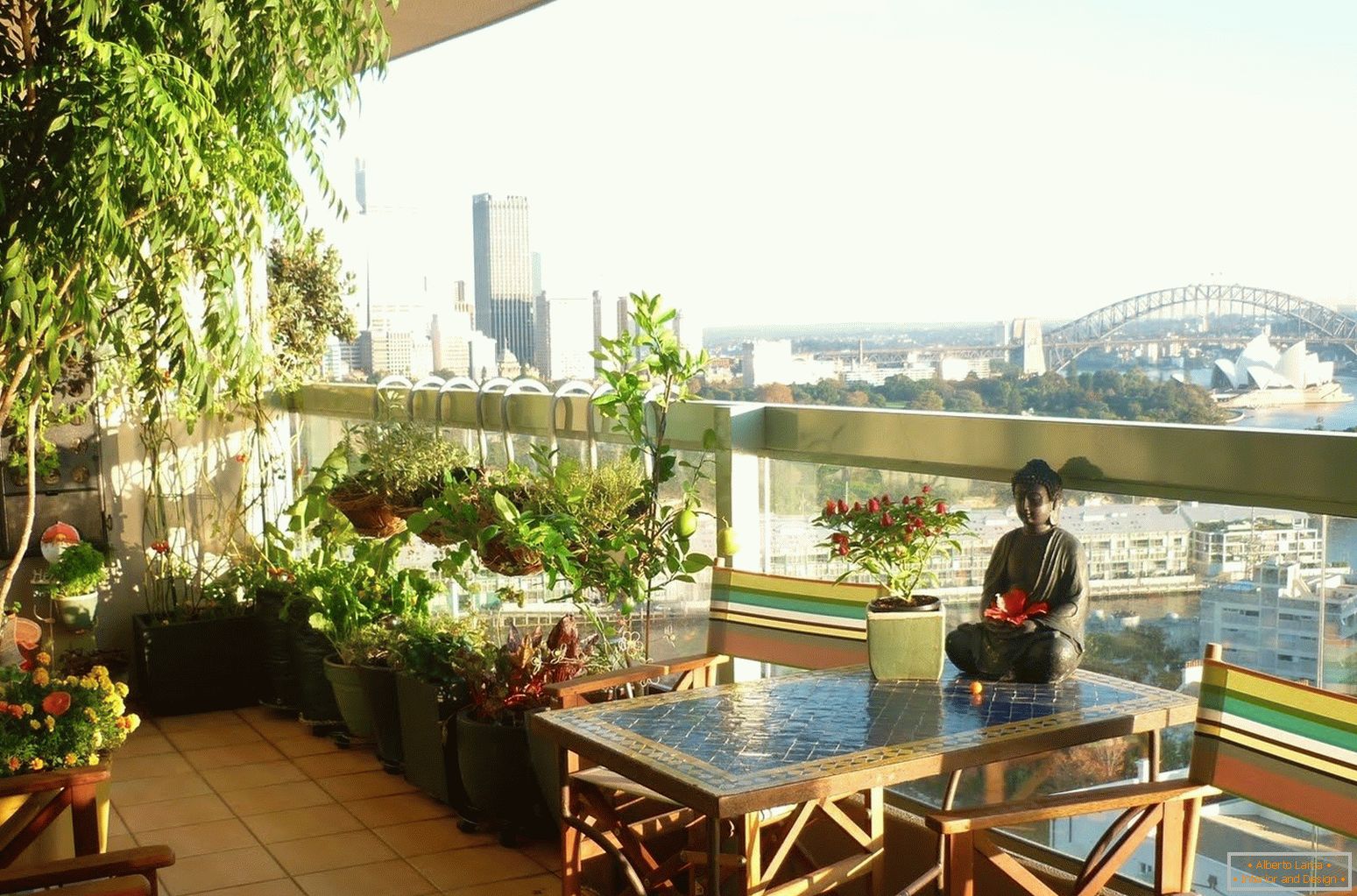
Location on the roof of a country house
Winter garden on the roof of a private house is an ideal option for small plots of land where there is no place for an annex or an individual pavilion. As a rule, such a premise has impressive dimensions, which makes it possible to equip a real oasis with separate zones. In expensive and luxurious apartments equipped with a glass roof-dome, on a sturdy frame, which as close as possible to the conditions for natural. In more budgetary versions, only part of the walls are made of transparent material.

In a private house on the veranda
The veranda serves as a kind of "waiting room". It is usually "cold", that is, it is not heated and is used only in summer for rest or evening gatherings. On it you can equip a buffer winter garden, that is, decorate it with plants only in the warm season. As an option, the veranda is insulated and connected to the central heating of the house. Now the garden will bloom and smell all year round. The walls of the veranda are traditionally 50% glazed, which is suitable for plants that need sunlight, and therefore serious repairs will not have to be planned.
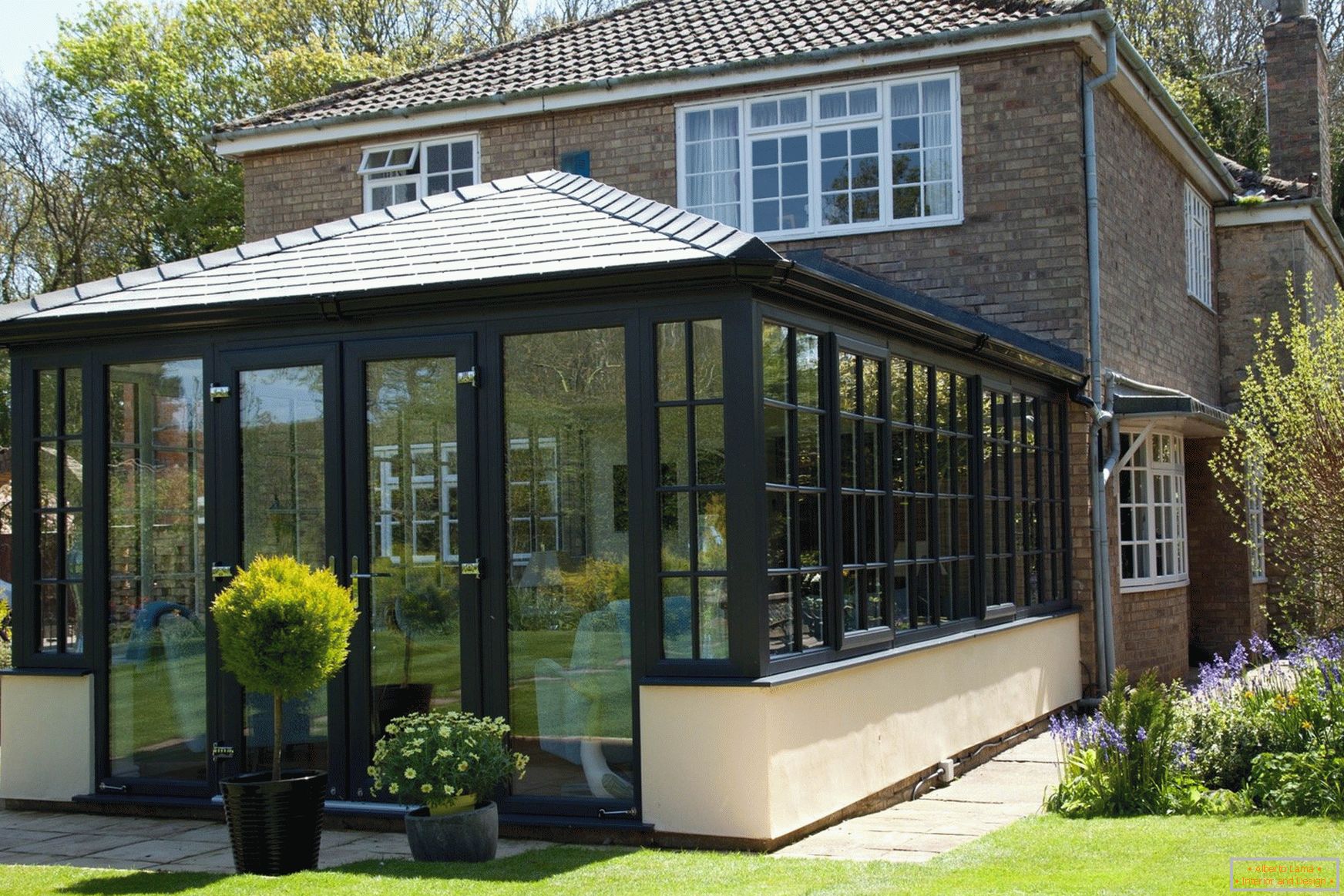
Conclusion
The winter garden has become a dream for many. Of course, it requires regular care, which will eat the lion's share of time, but the greenhouse will make you feel like a resident of a hot country where the sun always shines, and the vegetation blossoms all year round. In winter it is especially important to equip yourself with a quiet, secluded corner where there is no place for dejection and depression, where a piece of summer is preserved, and aromas that are in the air cause pleasant emotions and are charged with good mood.

